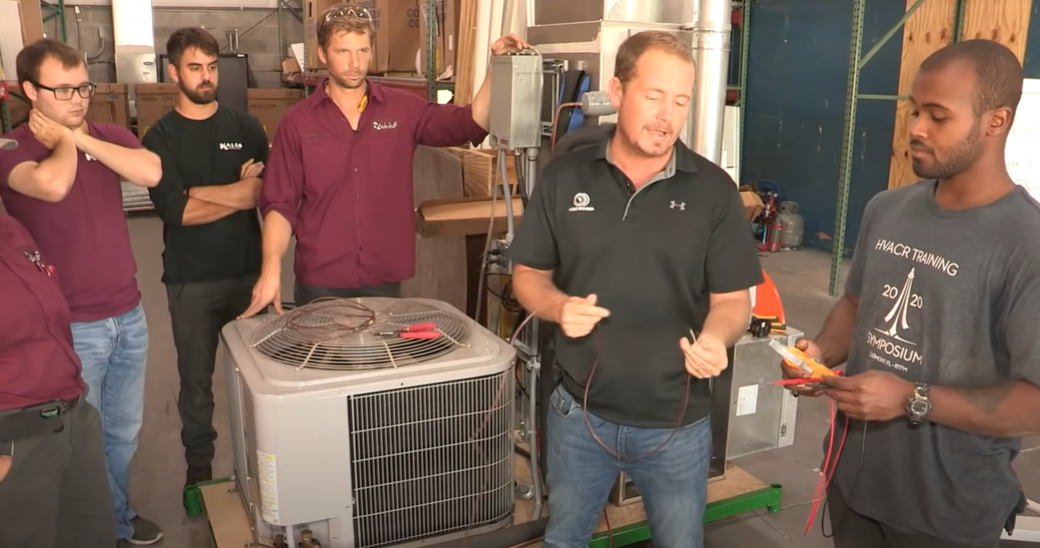Get Tech Tips
Subscribe to free tech tips.
Motor Speed – The Basics

How does a typical single phase motor know how fast to run?
Typical induction motors are dependent of the electrical cycle rate of the entering power (measured in hertz) for their speed.
Our power in the US makes one complete rotation from positive electrical peak to positive peak 60 times per second or 60hz (50hz in many other countries).

That means that the generators at the power plant would have to run at 3600 RPM if they only had two poles of power (60 cycles per second x 60 seconds per minute = 3600 rotations per minute). In reality, power plant generators can run at different speeds, depending on the number of magnetic poles within the generator. This phenomenon is replicated in motor design.
The more “poles” you have in a motor, the shorter the distance the motor needs to turn per cycle.
In a 2-pole motor, it rotates all the way around every cycle, making the no-load speed of a 2-pole motor in the US 3600 RPM.
A 4-pole motor only goes half the way around per cycle; this makes the no-load (Synchronous) RPM 1800.
6-pole is 1200 no-load (no slip).
8-pole is 900 no-load (no slip).
So, when you see a motor rated at 1075 RPM, it is a 6-pole motor with some allowance for load and slip.
An 825 RPM motor is an 8-pole motor with some allowance for slip.
A multi-tap/multi-speed single phase motor may have three or more “speed taps” on the motor. These taps just add additional winding resistance between run and common to increase the motor slip and slow the motor.
That means that a 1075 6-pole motor will run at a 1075 RPM underrated load at high speed. Medium speed will have greater winding resistance than the high speed and, therefore, greater slip. Low speed will have a greater winding resistance than medium and have an even greater slip.
Variable-speed ECM (electronically commutated motor) are motors that are powered by a variable frequency. In essence, the motor control takes the incoming electrical frequency and converts it to a new frequency (cycle rate) that no longer needs to be 60hz. This control over the actual frequency makes ECM motors so much more variable in the ten speeds they can run.
So, in summary, there are three ways you can change a motor speed:
- Change the number of poles (more = slower)
- Increase slip to make it slower, decrease slip to bring it closer to synchronous speed
- Alter the frequency (cycle rate)
—Bryan










Comments
Bryan, almost at the end of your tip on motor speeds from November 27th, 2016 there is a typo, the word “ten” should probably be “the”.
Bryan, almost at the end of your tip on motor speeds from November 27th, 2016 there is a typo, the word “ten” should probably be “the”.
Hello there, I discovered your web site by way of Google at the same time as searching for a comparable matter, your web site got here up, it seems good. I’ve bookmarked it in my google bookmarks.
Hi there, simply become aware of your weblog thru Google, and found that it is really informative. I’m gonna watch out for brussels. I will be grateful in the event you proceed this in future. Numerous other people might be benefited from your writing. Cheers!
Hello there, I discovered your web site by way of Google at the same time as searching for a comparable matter, your web site got here up, it seems good. I’ve bookmarked it in my google bookmarks.
Hi there, simply become aware of your weblog thru Google, and found that it is really informative. I’m gonna watch out for brussels. I will be grateful in the event you proceed this in future. Numerous other people might be benefited from your writing. Cheers!
Bryan,
Thanks for this post. I have been watching a few of your videos and I listen to the podcast. I have always taken amp draw readings for direct drive indoor blower motors during a normal maintenance. I have been doing some research and now am wondering if this test is invalid. The amp draw along tells me nothing. My question is during normal maintenance test how can I test this style of motor to see if it is still in good working order? TIA. JOHN
Bryan,
Thanks for this post. I have been watching a few of your videos and I listen to the podcast. I have always taken amp draw readings for direct drive indoor blower motors during a normal maintenance. I have been doing some research and now am wondering if this test is invalid. The amp draw along tells me nothing. My question is during normal maintenance test how can I test this style of motor to see if it is still in good working order? TIA. JOHN
Can you do a short on horsepower and “speed”, when we use rescue motors.
Can you do a short on horsepower and “speed”, when we use rescue motors.
I’d like to see this too
I’d like to see this too
I’m trying to find out what the individual rpms are for each speed tap. Example, 1/2hp 4 speed 1130rpm Genteq 3913 motor. Does 1130rpm stand for maximum rpms using the black wire, what are the rpms for the blue, orange and red?? Have looked everywhere and can’t find any info.
I’m trying to find out what the individual rpms are for each speed tap. Example, 1/2hp 4 speed 1130rpm Genteq 3913 motor. Does 1130rpm stand for maximum rpms using the black wire, what are the rpms for the blue, orange and red?? Have looked everywhere and can’t find any info.
You don’t find specifications for the lower motor speeds because they are very dependent on the load. As mentioned above, the lower speeds are achieved by adding resistance and inductance to increase the motor slip. A slip of 70 rpm at full load on the highest speed can be set by the motor design. For the lower speeds, they will be determined by the rpm at the intersection of the motor torque and load torque curves for each speed connection.
You don’t find specifications for the lower motor speeds because they are very dependent on the load. As mentioned above, the lower speeds are achieved by adding resistance and inductance to increase the motor slip. A slip of 70 rpm at full load on the highest speed can be set by the motor design. For the lower speeds, they will be determined by the rpm at the intersection of the motor torque and load torque curves for each speed connection.
You don’t find ratings for the lower motor speeds because they are very dependent on the motor load. The lower speeds are the result of adding inductance and resistance so the motor runs with more slip. A slip of 70 rpm at full load on the high speed winding can be set by the motor design. The slip on the lower speeds will depend on the rpm at the intersection of the motor torque and load torque curves for each speed connection.
You don’t find ratings for the lower motor speeds because they are very dependent on the motor load. The lower speeds are the result of adding inductance and resistance so the motor runs with more slip. A slip of 70 rpm at full load on the high speed winding can be set by the motor design. The slip on the lower speeds will depend on the rpm at the intersection of the motor torque and load torque curves for each speed connection.
To leave a comment, you need to log in.
Log In